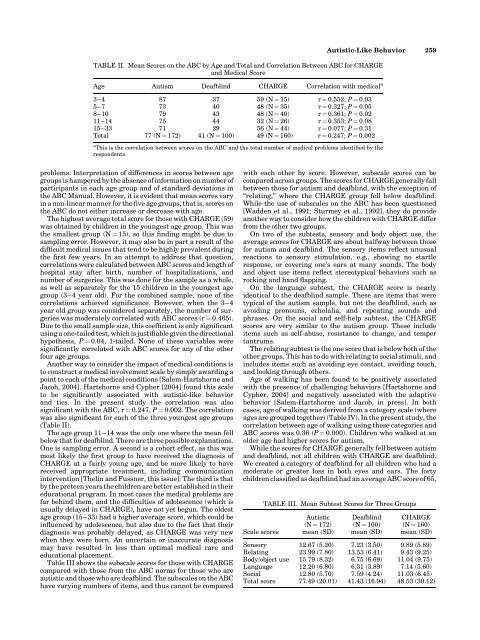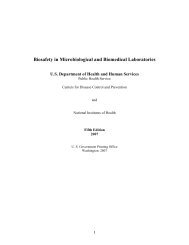Autistic-like behavior in CHARGE syndrome - Central Michigan ...
Autistic-like behavior in CHARGE syndrome - Central Michigan ...
Autistic-like behavior in CHARGE syndrome - Central Michigan ...
You also want an ePaper? Increase the reach of your titles
YUMPU automatically turns print PDFs into web optimized ePapers that Google loves.
TABLE II. Mean Scores on the ABC by Age and Total and Correlation Between ABC for <strong>CHARGE</strong><br />
and Medical Score<br />
Age Autism Deafbl<strong>in</strong>d <strong>CHARGE</strong> Correlation with medical a<br />
3–4 87 37 59 (N ¼ 15) r ¼ 0.552; P ¼ 0.03<br />
5–7 73 40 48 (N ¼ 35) r ¼ 0.327; P ¼ 0.05<br />
8–10 79 43 48 (N¼ 40) r ¼ 0.361; P ¼ 0.02<br />
11–14 75 44 32 (N ¼ 26) r ¼ 0.353; P ¼ 0.08<br />
15–33 71 29 56 (N ¼ 44) r ¼ 0.077; P ¼ 0.31<br />
Total 77 (N ¼ 172) 41 (N ¼ 100) 49 (N ¼ 160) r ¼ 0.247; P ¼ 0.002<br />
a<br />
This is the correlation between scores on the ABC and the total number of medical problems identified by the<br />
respondents.<br />
problems. Interpretation of differences <strong>in</strong> scores between age<br />
groups is hampered by the absence of <strong>in</strong>formation on number of<br />
participants <strong>in</strong> each age group and of standard deviations <strong>in</strong><br />
the ABC Manual. However, it is evident that mean scores vary<br />
<strong>in</strong> a non-l<strong>in</strong>ear manner for the five age groups, that is, scores on<br />
the ABC do not either <strong>in</strong>crease or decrease with age.<br />
The highest average total score for those with <strong>CHARGE</strong> (59)<br />
was obta<strong>in</strong>ed by children <strong>in</strong> the youngest age group. This was<br />
the smallest group (N ¼ 15), so this f<strong>in</strong>d<strong>in</strong>g might be due to<br />
sampl<strong>in</strong>g error. However, it may also be <strong>in</strong> part a result of the<br />
difficult medical issues that tend to be highly prevalent dur<strong>in</strong>g<br />
the first few years. In an attempt to address that question,<br />
correlations were calculated between ABC scores and length of<br />
hospital stay after birth, number of hospitalizations, and<br />
number of surgeries. This was done for the sample as a whole,<br />
as well as separately for the 15 children <strong>in</strong> the youngest age<br />
group (3–4 year old). For the comb<strong>in</strong>ed sample, none of the<br />
correlations achieved significance. However, when the 3–4<br />
year old group was considered separately, the number of surgeries<br />
was moderately correlated with ABC scores (r ¼ 0.465).<br />
Due to the small sample size, this coefficient is only significant<br />
us<strong>in</strong>g a one-tailed test, which is justifiable given the directional<br />
hypothesis, P ¼ 0.04, 1-tailed. None of these variables were<br />
significantly correlated with ABC scores for any of the other<br />
four age groups.<br />
Another way to consider the impact of medical conditions is<br />
to construct a medical <strong>in</strong>volvement scale by simply award<strong>in</strong>g a<br />
po<strong>in</strong>t to each of the medical conditions [Salem-Hartshorne and<br />
Jacob, 2004]. Hartshorne and Cypher [2004] found this scale<br />
to be significantly associated with autistic-<strong>like</strong> <strong>behavior</strong><br />
and tics. In the present study the correlation was also<br />
significant with the ABC, r ¼ 0.247, P ¼ 0.002. The correlation<br />
was also significant for each of the three youngest age groups<br />
(Table II).<br />
The age group 11–14 was the only one where the mean fell<br />
below that for deafbl<strong>in</strong>d. There are three possible explanations.<br />
One is sampl<strong>in</strong>g error. A second is a cohort effect, as this was<br />
most <strong>like</strong>ly the first group to have received the diagnosis of<br />
<strong>CHARGE</strong> at a fairly young age, and be more <strong>like</strong>ly to have<br />
received appropriate treatment, <strong>in</strong>clud<strong>in</strong>g communication<br />
<strong>in</strong>tervention [Thel<strong>in</strong> and Fussner, this issue]. The third is that<br />
by the preteen years the children are better established <strong>in</strong> their<br />
educational program. In most cases the medical problems are<br />
far beh<strong>in</strong>d them, and the difficulties of adolescence (which is<br />
usually delayed <strong>in</strong> <strong>CHARGE</strong>), have not yet begun. The oldest<br />
age group (15–33) had a higher average score, which could be<br />
<strong>in</strong>fluenced by adolescence, but also due to the fact that their<br />
diagnosis was probably delayed, as <strong>CHARGE</strong> was very new<br />
when they were born. An uncerta<strong>in</strong> or <strong>in</strong>accurate diagnosis<br />
may have resulted <strong>in</strong> less than optimal medical care and<br />
educational placement.<br />
Table III shows the subscale scores for those with <strong>CHARGE</strong><br />
compared with those from the ABC norms for those who are<br />
autistic and those who are deafbl<strong>in</strong>d. The subscales on the ABC<br />
have vary<strong>in</strong>g numbers of items, and thus cannot be compared<br />
with each other by score. However, subscale scores can be<br />
compared across groups. The scores for <strong>CHARGE</strong> generally fall<br />
between those for autism and deafbl<strong>in</strong>d, with the exception of<br />
‘‘relat<strong>in</strong>g,’’ where the <strong>CHARGE</strong> group fell below deafbl<strong>in</strong>d.<br />
While the use of subscales on the ABC has been questioned<br />
[Wadden et al., 1991; Sturmey et al., 1992], they do provide<br />
another way to consider how the children with <strong>CHARGE</strong> differ<br />
from the other two groups.<br />
On two of the subtests, sensory and body object use, the<br />
average scores for <strong>CHARGE</strong> are about halfway between those<br />
for autism and deafbl<strong>in</strong>d. The sensory items reflect unusual<br />
reactions to sensory stimulation, e.g., show<strong>in</strong>g no startle<br />
response, or cover<strong>in</strong>g one’s ears at many sounds. The body<br />
and object use items reflect stereotypical <strong>behavior</strong>s such as<br />
rock<strong>in</strong>g and hand flapp<strong>in</strong>g.<br />
On the language subtest, the <strong>CHARGE</strong> score is nearly<br />
identical to the deafbl<strong>in</strong>d sample. These are items that were<br />
typical of the autism sample, but not the deafbl<strong>in</strong>d, such as<br />
avoid<strong>in</strong>g pronouns, echolalia, and repeat<strong>in</strong>g sounds and<br />
phrases. On the social and self-help subtest, the <strong>CHARGE</strong><br />
scores are very similar to the autism group. These <strong>in</strong>clude<br />
items such as self-abuse, resistance to change, and temper<br />
tantrums.<br />
The relat<strong>in</strong>g subtest is the one score that is below both of the<br />
other groups. This has to do with relat<strong>in</strong>g to social stimuli, and<br />
<strong>in</strong>cludes items such as avoid<strong>in</strong>g eye contact, avoid<strong>in</strong>g touch,<br />
and look<strong>in</strong>g through others.<br />
Age of walk<strong>in</strong>g has been found to be positively associated<br />
with the presence of challeng<strong>in</strong>g <strong>behavior</strong>s [Hartshorne and<br />
Cypher, 2004] and negatively associated with the adaptive<br />
<strong>behavior</strong> [Salem-Hartshorne and Jacob, <strong>in</strong> press]. In both<br />
cases, age of walk<strong>in</strong>g was derived from a category scale (where<br />
ages are grouped together) (Table IV). In the present study, the<br />
correlation between age of walk<strong>in</strong>g us<strong>in</strong>g these categories and<br />
ABC scores was 0.36 (P ¼ 0.000). Children who walked at an<br />
older age had higher scores for autism.<br />
While the scores for <strong>CHARGE</strong> generally fell between autism<br />
and deafbl<strong>in</strong>d, not all children with <strong>CHARGE</strong> are deafbl<strong>in</strong>d.<br />
We created a category of deafbl<strong>in</strong>d for all children who had a<br />
moderate or greater loss <strong>in</strong> both eyes and ears. The forty<br />
children classified as deafbl<strong>in</strong>d had an average ABC score of 65,<br />
Scale scores<br />
TABLE III. Mean Subtest Scores for Three Groups<br />
<strong>Autistic</strong><br />
(N ¼ 172)<br />
mean (SD)<br />
<strong>Autistic</strong>-Like Behavior 259<br />
Deafbl<strong>in</strong>d<br />
(N ¼ 100)<br />
mean (SD)<br />
<strong>CHARGE</strong><br />
(N ¼ 160)<br />
mean (SD)<br />
Sensory 12.67 (5.20) 7.23 (3.50) 9.89 (5.89)<br />
Relat<strong>in</strong>g 23.99 (7.80) 13.53 (6.41) 9.43 (9.25)<br />
Body/object use 15.79 (8.32) 6.75 (6.69) 11.04 (9.75)<br />
Language 12.20 (6.80) 6.31 (3.89) 7.14 (5.60)<br />
Social 12.80 (5.70) 7.59 (4.24) 11.03 (6.45)<br />
Total score 77.49 (20.01) 41.43 (16.94) 48.53 (30.12)
















